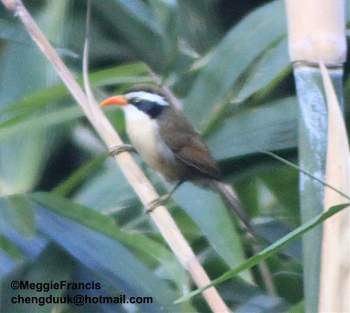(Third image deleted as wrong species) |
(Subspecies image added (replacing deleted one)) |
||
| Line 17: | Line 17: | ||
==Taxonomy== | ==Taxonomy== | ||
====Subspecies==== | ====Subspecies==== | ||
| + | [[Image:Coral-billed Scimitar Babbler.JPG|thumb|350px|right|Subspecies ''albogularis''<br />Photo by {{user|robby+thai|robby thai}}<br />Doi Phu Hom Pok NP, [[Thailand]], March 2017]] | ||
Seven subspecies recognized<sup>[[#References|[3]]]</sup>: | Seven subspecies recognized<sup>[[#References|[3]]]</sup>: | ||
* ''P. f. ferruginosus'' from east [[Nepal]] to northeast [[India]] and adjacent [[Tibet]] | * ''P. f. ferruginosus'' from east [[Nepal]] to northeast [[India]] and adjacent [[Tibet]] | ||
Revision as of 20:42, 18 October 2017
- Pomatorhinus ferruginosus
Identification
24 cm (9½ in). A largish Scimitar Babbler.
- Rather short, thick red bill
- Black mask with white supercilium
- Brown crown with black line over supercilium or all blackish crown
- Buff to dark rufous lower throat, breast and belly
- Upperparts greyish-brown
Sexes similar, juveniles are more rufescent above and below.
Confusion species
Red-billed Scimitar-Babbler has a thinner, longer and paler bill. It also lacks the black line over the supercilium (or the black crown)
Distribution
Found from east Nepal east over Bhutan to northeast India, adjacent Tibet, Burma, south China (Yunnan), Thailand, Laos and Vietnam.
Generally uncommon in its range. Only known from sightings in 1973 in Nepal.
Taxonomy
Subspecies
Seven subspecies recognized[3]:
- P. f. ferruginosus from east Nepal to northeast India and adjacent Tibet
- P. f. stanfordi from northeast India to north Burma and south China (Yunnan)
- P. f. formosus in northeast India (Meghalaya to Nagaland and Manipur)
- P. f. phayrei in Mizoram (northeast India) and southwest Burma
- P. f. albogularis in south and southeast Burma, northwest and north Thailand and northwest Laos
- P. f. orientalis in south China (Yunnan), northeast Laos and north Vietnam
- P. f. dickinsoni in south Laos and Vietnam
Rasmussen thinks that the nominate should be considered a separate species[2], but further study is needed.
Two further subspecies (mariae and namdapha) are not generally recognised[4]
Habitat
Broadleaf evergreen forest, bamboo, secondary growth or wild banana groves in gulleys. Found at 400 - 2400 m in the Indian Subcontinent, at 800 - 2285 m in southeast Asia and China.
Behaviour
Diet
Feeds on insects and their larvae. Reported to peel of and eat thin stripes of bamboo.
Very elusive and hard to see. Usually in pairs or small groups. Often on ground, reluctant to fly.
Breeding
Breeding season from April to August. The nest is an oval or bulky cone made of dry bamboo, rattan, grasses, plant fibres, stems and other material. It's placed on the ground or low down in a bush, sapling or bamboo clump. Lays 3 - 5 eggs.
Movements
Resident species.
References
- Del Hoyo, J, A Elliott, and D Christie, eds. 2007. Handbook of the Birds of the World. Volume 12: Picathartes to Tits and Chickadees. Barcelona: Lynx Edicions. ISBN 978-8496553422
- Rasmussen, PC and JC Anderton. 2005. Birds of South Asia: The Ripley Guide. Barcelona: Lynx Edicions. ISBN 978-8487334672
- Clements, J. F., T. S. Schulenberg, M. J. Iliff, D. Roberson, T. A. Fredericks, B. L. Sullivan, and C. L. Wood. 2017. The eBird/Clements checklist of birds of the world: v2017, with updates to August 2017. Downloaded from http://www.birds.cornell.edu/clementschecklist/download/
- Avibase
Recommended Citation
- BirdForum Opus contributors. (2024) Black-crowned Scimitar Babbler. In: BirdForum, the forum for wild birds and birding. Retrieved 26 April 2024 from https://www.birdforum.net/opus/Black-crowned_Scimitar_Babbler






